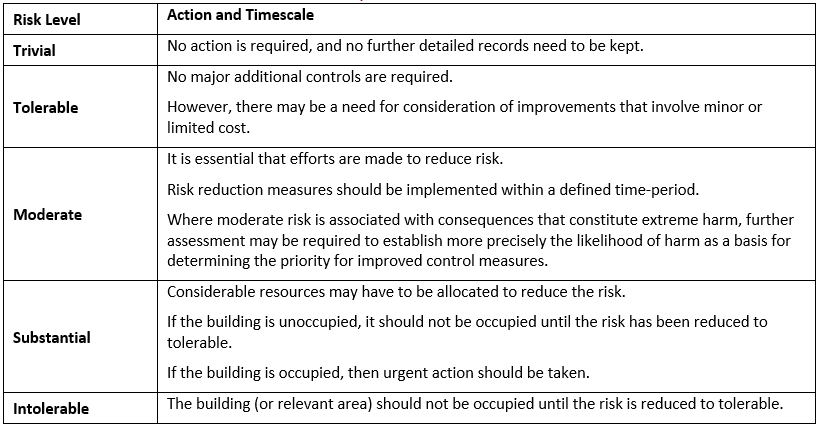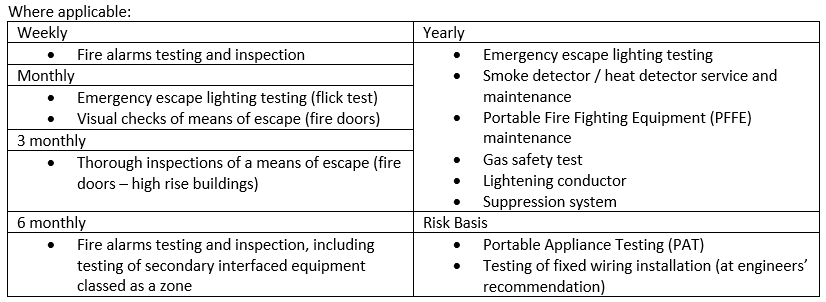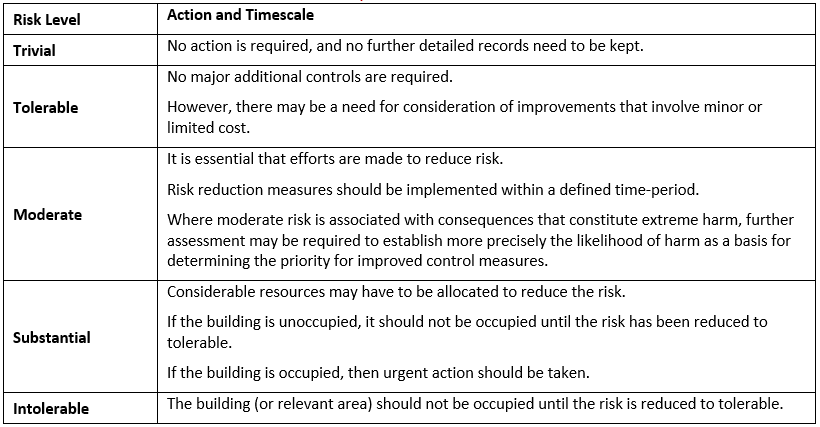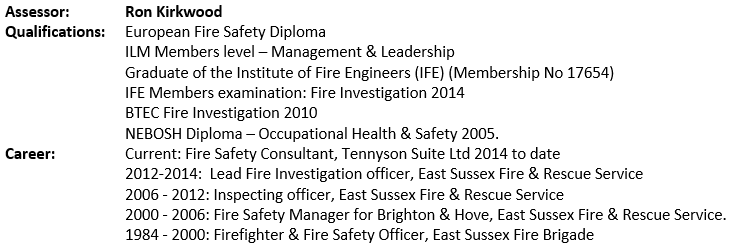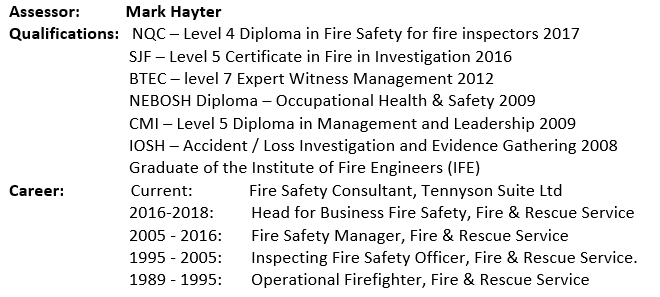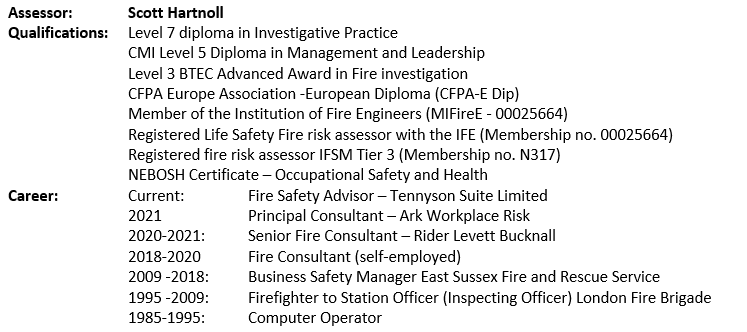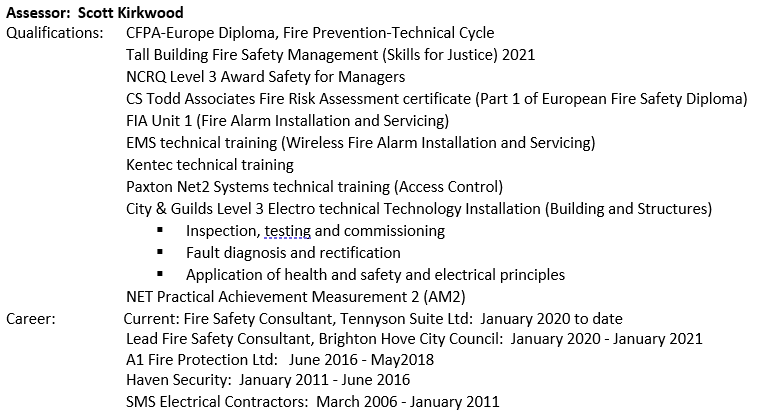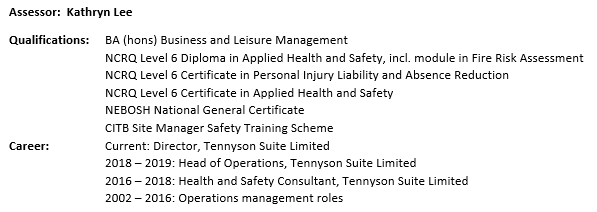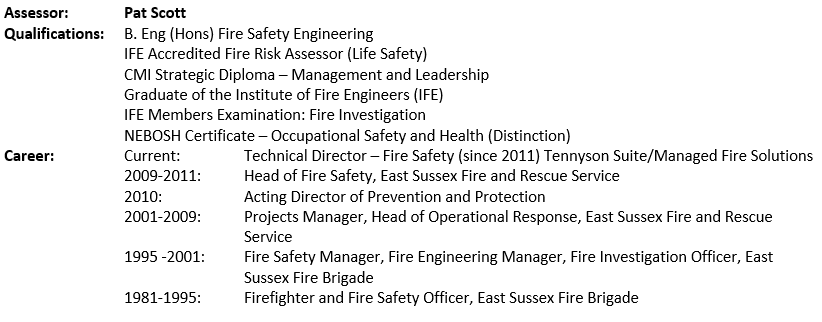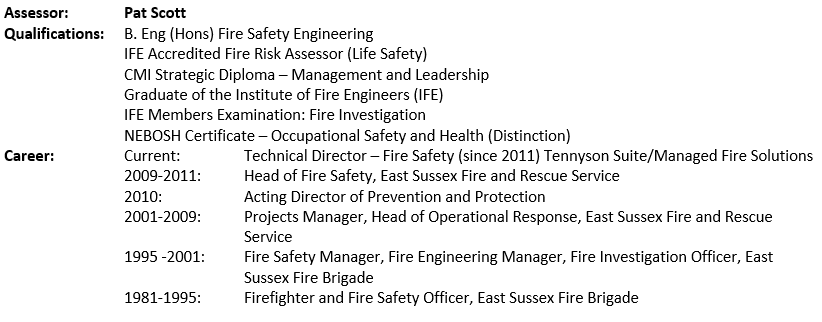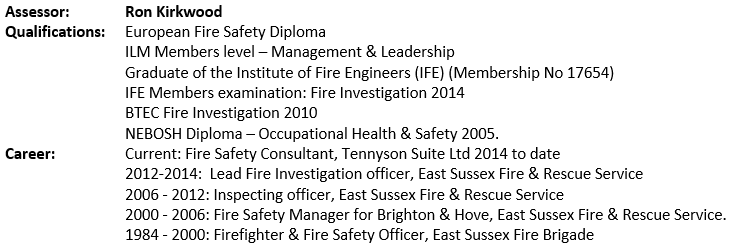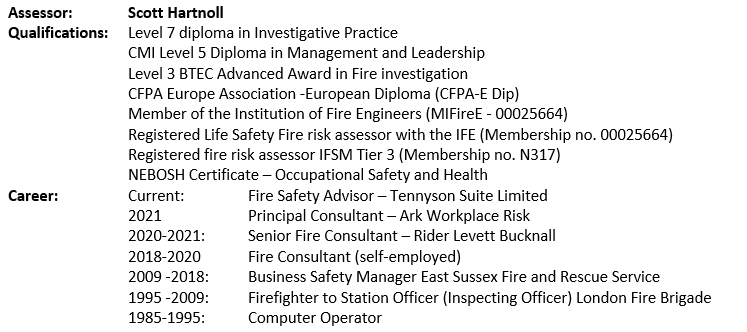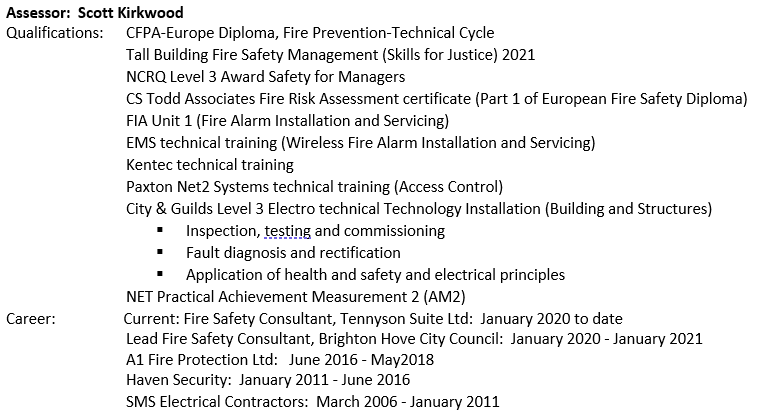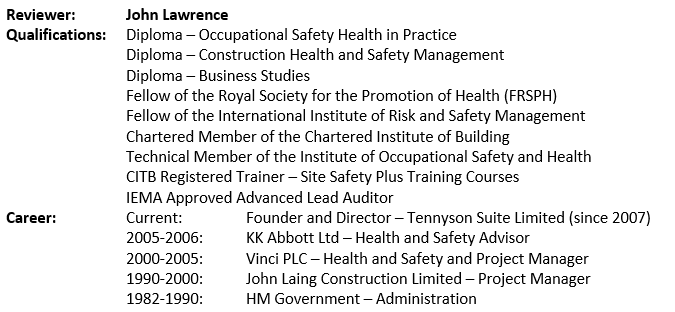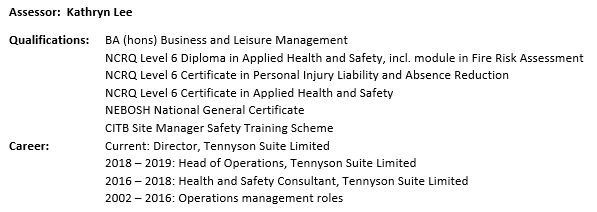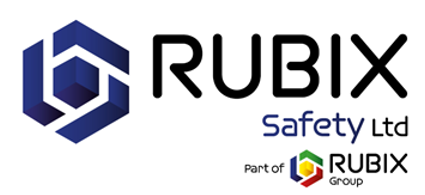Title Page
-
Premises Address
-
Image of front of premises
-
Assessment Summary: Risk - Life Safety
-
Assessment Summary: Risk - Building Preservation
-
Premises inspection conducted on
-
Report prepared by
-
Revision number
-
Revision Content
-
Revision Author
-
Revision re-issue date
-
Report issue date
-
Recommended Review Date
Assessment Summary
-
The summary of fire risk for life safety and building preservation identified on the front page of this document and repeated below, is based on conditions seen at the time of the assessment. The summary of ‘Descriptors’ are likely to change following successful completion of the Action Plan.
-
Risk - Life Safety
-
Risk - Building Preservation
Maintenance & Testing
-
The Responsible Person(s) should ensure that statutory fire maintenance is carried out in the Premises. Listed below are the basic statutory tests and maintenance routines which must be carried out to ensure that fire precautions are not compromised.
Further details of the inspections undertaken, and the exact nature of all fire precautions are outlined in the relevant British Standards.
Introduction
-
Tennyson Suite Limited has been instructed by the Responsible Person, on behalf of the client, to complete a fire risk assessment in accordance with the Regulatory Reform (Fire Safety) Order 2005, on the premises identified on the front page of this document; the address hereafter referred to as the Premises.
-
The fire risk assessment is an organised and methodical inspection at the Premises, the activities within the Premises, the potential for a fire to occur and the harm it could cause to the people in and around the Premises.
-
The existing fire safety measures are evaluated and assessed against the current legal compliance to establish whether they are adequate or if more is required to be done. Its purpose is to inform those responsible for fire safety within the Premises, or area of consideration, of the relevant risks that need to be managed or addressed, per the assessment.
Site Details
-
Responsible Person (Employer/Person in control of the premises):
-
Name of person(s) responsible for/in control of fire safety:
-
Contact name, role, and responsibility of person present during assessment:
-
Has there been a previous fire risk assessment?
-
Have actions been completed?
-
Date of previous fire risk assessment
-
Has the premises been issued with enforcement action?
-
Have all identified areas of non-compliance been remediated?
-
Has there been an incident of fire, or false activation that was attended by the fire and rescue service?
Scope of Assessment & Methodology
-
The scope of the assessment relates to the Premises for which the Responsible Person has control only.
The assessment is based on the activities and processes seen on the day of the inspection.
The assessment inspection was non-invasive and no building component, machinery, plant or equipment was disassembled or uncovered. -
The Fire Risk Assessment Methodology adopted for this assessment is based upon the reference document: Publicly Available Specification 79 (PAS 79) – Fire Risk Assessment Guidance and Methodology.
Premises Description
-
Property Use
-
Number of floors
-
Number of floors below ground
-
Loft Space
-
Approximate Area (m2)
-
Location Description
-
Construction Details
-
External Wall
-
Age of Construction
-
External Areas
-
Means of Escape Arrangements
-
Fire Alarm and Detection Category
-
Notes:
Overview of Findings - Life Safety
-
Overview of the fire safety provisions and conditions in regard to life safety:
-
It is for the reasons given above that a grading has been concluded for Life Safety for these Premises as:
Overview of Findings - Building Preservation
-
Overview of the fire safety provisions and conditions in regard to building preservation:
-
It is for the reasons given above that a grading has been concluded for Building Preservation for these Premises as:
Fire Risk Audit Findings - Sources of Ignition
-
Upon visual inspection, is the condition of the fixed electrical installation assessed to be adequate to prevent accidental ignition of fire and /or fire spread?
-
Upon visual inspection, is the visible condition of portable electrical appliances assessed to be adequate to prevent accidental ignition of fire and /or fire spread?
-
Are the arrangements for smoking adequate to prevent accidental ignition of fire and /or fire spread?
-
Are there adequate arrangements in place for preventing arson/ fire setting?
-
Are the facilities for heating and ventilation of the Premises in suitable visible condition to prevent accidental ignition of fire and /or fire spread?
-
Are the provisions for heating food and drink in suitable visible condition to prevent accidental ignition of fire and /or fire spread?
-
Are the arrangements for controlling 'hot works' sufficient to prevent accidental ignition of fire and /or fire spread?
-
Are arrangements for storing, handling, using and disposing of hazardous materials/substances sufficient to prevent accidental ignition of fire and /or fire spread?
-
Are the existing work processes, as reported by the responsible person, adequate to prevent accidental to prevent accidental ignition of fire and /or fire spread?
-
Are the arrangement for controlling building and maintenance work sufficient to prevent accidental ignition of fire and /or fire spread?
-
Are plant rooms and high risk areas (including passenger / goods lifts) well managed and maintained to prevent accidental ignition of fire and /or fire spread?
-
Are there external risk factors present (including vehicles/parking/fuel storage), and are they being sufficiently controlled to prevent accidental ignition of fire and /or fire spread? (provide detail in the notes section)
-
Is the use, storage and maintenance of electric vehicles sufficiently controlled to prevent accidental ignition of fire and/or fire spread? provide details in notes section),
-
Are arrangements for charging electric vehicles and appliances adequately controlled to prevent the accidental ignition fire and/or fire spread (provide details in the notes section)
-
Are any other risk areas present within the premises or its environs, and are they being sufficiently controlled to prevent accidental ignition of fire and /or fire spread? (provide detail in the notes section)
Fire Risk Audit Findings - Persons at Risk
-
Have staff (including young workers) been given suitable fire awareness training, that is regularly refreshed?
-
Have staff (including young workers) been trained in the evacuation procedure?
-
Is evacuation training refreshed regularly?
-
Are there members of staff with disabilities?
-
Has a PEEP been produced for members of staff with a disability?
-
Are there arrangements in place for producing a PEEP for newly employed members of staff with a disability?
-
What arrangements are in place for evacuating visitors or members of the public with disabilities?
-
Are arrangements adequate to prevent a delay in evacuation?
-
What arrangements are in place for protection of customers and visitors to the premises?
-
Are arrangements adequate to prevent a delay in evacuation?
-
What arrangements are in place for protection of contractors?
-
Are arrangements adequate to prevent a delay in evacuation?
-
What arrangements are in place for protection of lone workers?
-
Are arrangements adequate to prevent a delay in evacuation?
-
Does the premises have facility for staff to sleep at the premises?
-
What arrangements are in place to protect sleeping occupants?
-
Are arrangements adequate to prevent a delay in evacuation?
-
Are there any other observations to note?
Fire Risk Audit Findings - Fire Protection Measures
-
Have there been any significant changes to the protection measures provided at the premises since the last fire risk assessment? (provide detail in the notes section)
-
Do changes the that have been made improve or maintain the level of fire safety for the premises?
-
Upon visual inspection, is the fire alarm and detection for the Premises in good order, free from faults and obvious signs of damage?
-
Upon visual inspection, is the emergency lighting for the Premises in good order, free from obvious signs of damage or defects?
-
Upon visual inspection, is the compartmentation (walls, floors, ceilings) of the Premises in good order, free from obvious breaches?
-
Upon visual inspection, is the condition of the external wall and any attachments in good order, free from obvious damage, breaches or mis-use?
-
Upon visual inspection, are fire doors around the premises in good condition, free from obvious signs of damage or disrepair?
-
Upon visual inspection, is the firefighting equipment for the Premises well maintained, serviced and in date?
-
Upon visual inspection, is the fire suppression system for the Premises well maintained, free from faults and obvious signs of damage?
-
Are there any other fire safety systems provided at the Premises and are they being sufficiently maintained? (provide detail in the notes section)
-
Are the fire safety signs and notices positioned correctly to aid emergency evacuation and are they compliant to BS5499?
-
Are travel distances for escape routes within permissible levels under ADB, or are there sufficient mitigating measures in place to justify, within the Premises overall fire strategy, any extension under BS9999? (provide detail in the notes section)
-
Is there sufficient quantity and size (width) of fire exits to accommodate the permitted occupancy of the Premises and provide alternate means of escape?
-
Is the external means of escape sufficient planned, managed, and controlled to aid evacuation (such as height above ground, ramps, guard rails, weather protection)?
-
Upon visual inspection, are provisions to assist evacuation of people with disabilities, (such as refuge areas, aids, door widths) well maintained and free from damage or defects?
-
Are there any other fire protection measures in place, and are they being sufficiently maintained to reduce the risk of fire?
Fire Risk Audit Findings - Fire Safety Management
-
Is there an up to date Fire Safety Policy for the premises, with suitable procedures for implementation?
-
Are there any outstanding actions, observations or major changes since the previous fire risk assessment?
-
Is there evidence of staff training having been carried out?
-
Is training to a suitable level for the responsibilities held?
-
Is training refreshed at suitable intervals?
-
Is there evidence of regular fire drills being completed?
-
Are sufficient number of persons within the business appointed as Fire Marshal(s)/ Incident Controller
-
Is there a fire safety logbook for the premises?
-
Is the fire safety logbook actively and accurately used to record actions and incidents?
-
Is there evidence that fire escape routes are visually checked each month (in house)?
-
Are any issues recorded, reported and remediated?
-
Is there evidence that the fire alarm is being tested weekly (in house)?
-
Are any issues recorded, reported and remediated?
-
Is there evidence that the fire alarm is being inspected, tested and serviced by a competent contractor every 3 months?
-
Are any issues recorded, reported and remediated?
-
Is there evidence that emergency lighting is being tested (flick test) monthly or more frequently (in house)?
-
Are any issues recorded, reported and remediated?
-
Is there evidence that emergency lighting is being tested by a competent contractor every 12 months?
-
Are any issues recorded, reported and remediated?
-
Is there evidence that FF Equipment is being serviced in accordance with manufacturer's instructions?
-
Are any issues recorded, reported and remediated?
-
Is there evidence that suppression systems are being tested by a competent contractor every 12 months?
-
Are any issues recorded, reported and remediated?
-
Is there evidence of other fire safety systems being tested in accordance with manufacturer's instructions or legislative requirement?
-
Are any issues recorded, reported and remediated?
-
Is there evidence of the fixed electrical installation being tested every 5 years?
-
Are any issues recorded, reported and remediated?
-
Is there evidence of portable appliances being tested?
-
Are any issues recorded, reported and remediated?
-
Is there evidence of the lightning protection for the premises being tested?
-
Is testing completed every 11 months to take account of changing climatic conditions?
-
What Housekeeping / Management / Storage arrangements are in place?
-
Are Housekeeping / Management / Storage arrangements sufficient to prevent fire spread?
-
Does the premises have areas with furniture and furnishings, such as offices, lounges, receptions, restaurants?
-
Does the furniture and furnishings comply with the relevant class of material non-flammability?
-
Is the premises furniture and furnishings in good order, without visible signs of degradation or deliberate damage?
-
Is lighting for escape routes reliant upon artificial and/or natural sources?
-
Is lighting observed to be adequate on escape routes at the time of inspection?
-
What waste disposal arrangements are in place?
-
Are waste disposal arrangements sufficient to prevent accidental or deliberate fire spread?
-
What site security procedures are in place?
-
Are site security procedures suitable and sufficient to prevent potential arson, misuse of equipment or similar?
-
What are the arrangements for control of contractors (i.e. permits to work- including ‘Hot Works’)
-
Are arrangements for control of contractors sufficient to reduce the risk of fire start or spread?
-
What arrangements are in place for the fire and rescue service (facilities, access, visits, building information)?
-
Are arrangements for the fire and rescue service adequate to assist with fire fighting measures?
-
Are there any other observations to note?
Assessed Consequences of Fire
-
Utilising the consequence/harm terms detailed in PAS 79, the consequence assessment for fires within the Premises is given below, in relation to life safety, where:
-
Life Safety
-
Again, utilising the consequence/harm terms detailed in PAS 79, the consequence assessment for fires within the Premises is given below, in relation to building preservation, where:
-
Building Preservation
Likelihood of Fire
-
Following the process detailed in PAS 79, a judgement on the likelihood of fire in this section needs to be considered and established. There are three definitions for likelihood; these being suggested as:
-
Likelihood considered for this fire risk assessment
Fire Risk Assessment Summary
-
Using the fire estimator table and assessment factors from consequences of fire indicator as well as the likelihood of fire indicator above, the risk assessment for Life Safety and Building Preservation (from PAS 79) in this Premises is:
-
Life Safety
-
Building Preservation
-
Regulatory Reform Order
-
The following information cross-references the sections of this document with the Articles 9-22 of the RRFSO 2005.
-
Article 9 - Risk Assessment
-
Article 10 - Principles of Prevention
-
Article 11 - Fire Safety Arrangements
-
Article 12 - Elimination or Reduction of Risks from Dangerous Substances
-
Article 13 - Fire- Fighting and Detection
-
Article 14 - Emergency Routes and Exits
-
Article 15 - Procedures for Serious and Imminent Danger and for Danger Areas
-
Article 16 - Additional Emergency Measures respect of Dangerous Substances and any incident that may arise from their presence.
-
Article 17 - Maintenance
-
Article 18 - Safety Assistance
-
Article 19 - Provision of Information to Employees
-
Article 20 Provision of Information to Employers and the Self-Employed from outside undertakings
-
Article 21 - Training
-
Article 22 - Co-operation and Co-ordination
Managing Building Work and Alterations
-
Before any building work starts or material alterations are made to the Premises, a review of the fire risk assessment is required to consider what additional risks are likely to be introduced.
-
An evaluation of the risks to people should be undertaken, particularly in those areas of the premises or adjacent areas that continue to be occupied.
-
In many cases this will mean a minor change/addition to the documentation and will not necessarily require a completely new assessment. However, when the change has a significant impact, for example on the means of escape, then it recommended that a site inspection should be undertaken by a competent assessor and a new fire risk assessment be provided for the construction works.
-
Any structural alterations may also require Building Regulations approval. A re-assessment following building work and alterations should be undertaken on the Premises in those areas where alterations have been made to fully assess the Premises.
Competence of Assessor
-
Tennyson Suite Limited is a Chartered Building Consultancy and is accredited to ISO 9001; OHSAS 45001; and BS EN ISO 14001 to provide specialist health and safety advice on the following: CDM advisers to clients, designers, principal designers, principal contractors and contractors, principal designer duties, construction phase health and safety plans, risk assessments including fire risk assessments and method statements, health and safety policies, design and delivery of training programmes for the construction industry and wider commercial applications.
-
Contact: Tennyson Suite - Unit Y Rich Industrial Estate, Avis Way, Newhaven, BN9 0DU
01273 646737 / enquiries@tennyson-suite.co.uk -
Assessor
-
-
-
-
-
-
-
-
Reviewer
-
-
-
-
-
-
-
Relevant Legislation
-
The following guidance and legislation is relevant to this Fire Risk Assessment:
-
• The Regulatory Reform (Fire Safety) Order 2005.
-
• The Dangerous Substances and Explosive Atmospheres Regulations 2002.
-
• Management of Health and Safety at Work Regulations 1999.
-
• Workplace (Health, Safety and Welfare) Regulations 1992.
-
• Health and Safety (Safety Signs and Signals) Regulations 1996.
-
• The Electricity at Work Regulations 1989.
-
• British Standard 5839-1: 2002 – Fire detection and fire alarm systems for buildings.
-
Code of practice for system design, installation, commissioning and maintenance.
-
• British Standard 5266-1: 2011 – Emergency lighting. Code of practice for the emergency escape lighting of premises.
-
• British Standard 7176: 1995 - Specification for resistance to ignition of upholstered furniture for non-domestic seating by testing composites.






